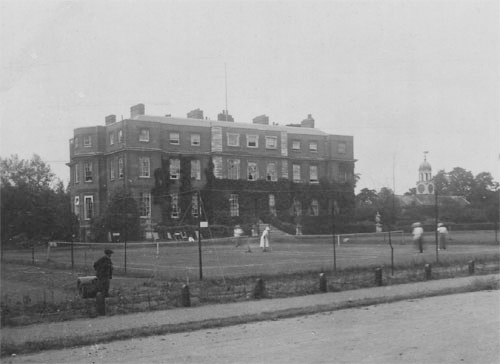Gidea Hall
Essex
| Location | Romford | ||
| Year demolished | 1930 | ||
| Reason | Urban growth | ||
| See all images: | Gallery | ||
| << Back to the main list |
There was first a house in Gidea Park in the 13th century - though the mansion that was the final Gidea Hall had undergone many modifications and several rebuilds in the intervening years. Gidea Hall had been the home of the leading local families for many years but, like many of the houses near London, rapid urban expansion removed its seclusion and peace. The need for housing also meant that the house and grounds occupied now valuable development land.
 Though there isn't a detailed history of the owners of the Hall it's possible to identify some owners. One was Sir Anthony Cooke (b. 1504 - d. 1576) who was renowned for his knowledge of Greek, Latin, poetry and mathematics. He was a politician and religious reformer as well as tutor to Edward VI and Lady Jane Grey. The Cookes were the leading local family - it is known that on 17-18 July 1568 Queen Elizabeth stayed at Gidea Hall as she travelled through the area after stopping at her own Havering Palace from 14-16 July. She was not the first queen to stay overnight as Queen Marie de Medici, mother-in-law of Charles I, and Queen of France had stayed in 1637 or 1638 on her way from Harwich to London. She had been staying with Charles I at Havering but preferred the more stylish surroundings of Gidea Hall to the rather more spartan Havering Palace.
Though there isn't a detailed history of the owners of the Hall it's possible to identify some owners. One was Sir Anthony Cooke (b. 1504 - d. 1576) who was renowned for his knowledge of Greek, Latin, poetry and mathematics. He was a politician and religious reformer as well as tutor to Edward VI and Lady Jane Grey. The Cookes were the leading local family - it is known that on 17-18 July 1568 Queen Elizabeth stayed at Gidea Hall as she travelled through the area after stopping at her own Havering Palace from 14-16 July. She was not the first queen to stay overnight as Queen Marie de Medici, mother-in-law of Charles I, and Queen of France had stayed in 1637 or 1638 on her way from Harwich to London. She had been staying with Charles I at Havering but preferred the more stylish surroundings of Gidea Hall to the rather more spartan Havering Palace.
It is known that the house was then owned by Sir John Eyles who rebuilt the Hall in 1725. It was then sold to Richard Benyon - (b. 26 Nov 1698 - d. 1774) in 1745 who enlarged it in 1766. Little is known about Benyon's early life but rose in the ranks of the East India Company, eventually becoming Governor of Fort St. George in Madras and accumulating a £75,000 fortune (approx. £9m) in the process.
The rapid growth of London in the early 20th century meant that much of the countryside between the main city and the surrounding towns and villages had been filled with houses. This increased the pressure on any remaining areas available for development. The large houses, with their large grounds, which had previously been far from the urban sprawl, were now prime building plots. In 1911 the grounds of the Hall were opened as the picturesque Romford Garden Suburb, the houses built by famous architects of the day such as Parker and Unwin, Baillie Scott, Randall Wells, Curtis Green, Clough Williams Ellis, and Bunney & Makins. The Hall was finally demolished in 1930. The space the Hall occupied is now an open area used by a tennis club.